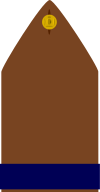77th Brigade (United Kingdom)
[9][11][12] On 6 August 1914, less than 48 hours after Britain's declaration of war, Parliament sanctioned an increase of 500,000 men for the Regular British Army.
The newly-appointed Secretary of State for War, Earl Kitchener of Khartoum, issued his famous call to arms: 'Your King and Country Need You', urging the first 100,000 volunteers to come forward.
Shekleton, who had been Assistant Adjutant and Quartermaster General (AA&QMG) in the Malta Garrison on the outbreak of war, was appointed Temporary Brigadier-General to command 77th Bde on 25 September 1914.
[a] Brigade headquarters (HQ) formed at Codford St Mary on the edge of Salisbury Plain, where the battalions arrived from their regimental depots in September and October.
It took longer to obtain drill-pattern rifles and accoutrements, but barrack-square training continued until the weather worsened at the end of October, turning the drill ground and tent floors into a sea of mud.
Between 26 April and 8 May the units returned to Salisbury Plain and were concentrated in huts between Sutton Veny and Longbridge Deverill near Warminster.
The division completed its mobilisation on 10 September and was ordered to France to join the British Expeditionary Force on the Western Front.
On 26 December the first units moved out of the Salonika base area to Happy Valley Camp, where the division completed its concentration on 8 February 1916.
Because of the movement difficulties in the mountainous terrain, the British Salonika Army (BSA) reorganised its transport to rely on pack mules.
The main attack (the Second Battle of Doiran) was carried out at dusk on 24 April after three days of artillery fire to cut the Bulgarian barbed wire.
12th Argyll & Sutherland Highlanders set off from its camp by the railway at 01.30 on 25 April and marched about 2 miles (3.2 km) to enter the Jumeaux Ravine, where it found the trenches blocked with wounded and stretcher-parties.
Here they began to consolidate the position, but finding that they were isolated by the failures on either flank and that all their officers were casualties, the men withdrew after about half an hour without any warning having reached Brigade HQ.
8th Royal Scots Fusiliers had placed one company at the disposal of each of the attacking battalions to help hold the objectives: they slowly made their way up shelled and congested communication trenches.
Bulgarian losses were very heavy, but the British also lost 54 men including casualties to parties making demonstrations on other parts of the line.
As the battalions climbed higher towards the Tongue, the Knot and the Tassel, they ran into heavier fire, some of it from machine guns in a concealed concrete emplacement.
With both flanks 'in the air', under fire from the Plume and Rockies in front and with ammunition running low, 77th Bde was in a dangerous position on the Tongue.
By the time ammunition arrived the Bulgarian bombardment had intensified and parties were working their way round the brigade's flanks and rear: Falconar Stewart had made the decision to withdraw by battalions, evacuating the wounded and equipment.
11th Scottish Rifles led off, followed by 8th RSF, but when it was 12th A&SH's turn to retire, enemy parties got among the battalion in the smoke and confusion, and succeeded in capturing a number of them; Falconar Stewart was killed in the melée.
77th Brigade entrained at Radomir on 20 October and reached Mustafa Pasha (west of Adrianople) next day, accompanied by Lieutenant-General Sir Charles Briggs.
All units of 26th Division wore a simple blue tape across the base of the shoulder straps, introduced as the divisional sign in July 1916.
[35] However, when the division was first formed and no uniforms or regimental badges were available, the battalions in each brigade were temporarily distinguished by a coloured cloth patch in buff, blue, white or green.
[10] The following officers commanded 77th Brigade during World War I:[10][21] The Security Assistance Group (SAG)'s mission was to work with cross-Whitehall agencies to achieve the goals of Defence Engagement and Building Stability Overseas Strategies.
77th Brigade was created to draw together a host of existing and developing capabilities essential to meet the challenges of modern conflict and warfare.
Specifically, it is to: Provide support to other government departments in the aim to achieve stability overseas; lead on special influence methods; build military capacity in all stages of conflict.
[7]In 2019, Laurie Clarke in Wired described the brigade as a "psychological operations unit responsible for 'non-lethal' warfare that reportedly uses social media to "control the narrative", as well as disseminating UK government-friendly podcasts and videos".
[7] From 2022 under the Future Soldier programme the structure of the brigade became:[39] Initially designated as the Security Assistance Group, the formation included the following units:[40] In July 2015 and October 2015, the headquarters and four subordinate elements were reshaped into six 'Columns'.
[11][12] David Miller, then a professor of political sociology at the University of Bristol studying British government propaganda and public relations, said that it is "involved in manipulation of the media including using fake online profiles".
[61][62] On 22 April 2020, during the UK government's daily coronavirus briefing, General Nick Carter confirmed that 77th Brigade are working with the Home Office Rapid Response Unit "helping to quash rumours from misinformation, but also to counter disinformation".
A government spokesman stated in response "These units used publicly available data, including material shared on social media platforms, to assess UK disinformation trends and narratives.



